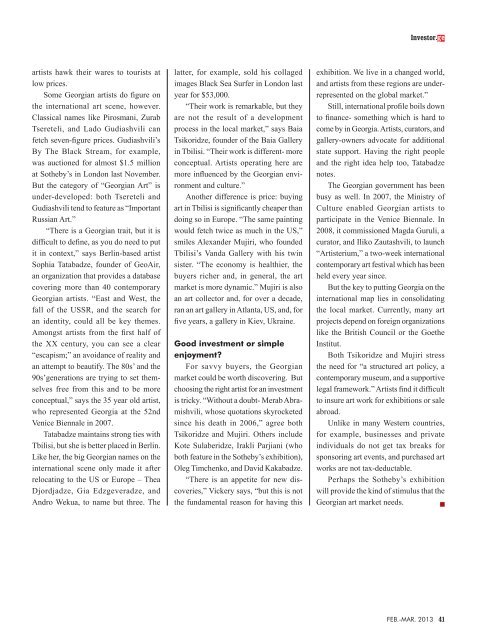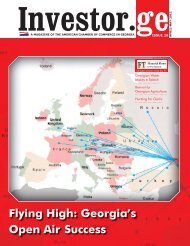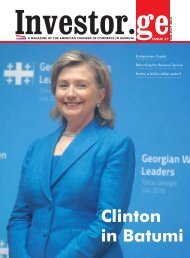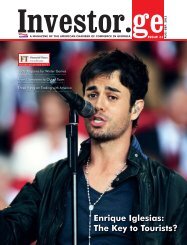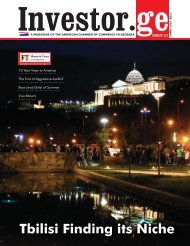Issue 1, 2013 February-March - Investor.ge
Issue 1, 2013 February-March - Investor.ge
Issue 1, 2013 February-March - Investor.ge
- No tags were found...
You also want an ePaper? Increase the reach of your titles
YUMPU automatically turns print PDFs into web optimized ePapers that Google loves.
artists hawk their wares to tourists atlow prices.Some Georgian artists do figure onthe international art scene, however.Classical names like Pirosmani, ZurabTsereteli, and Lado Gudiashvili canfetch seven-figure prices. Gudiashvili’sBy The Black Stream, for example,was auctioned for almost $1.5 millionat Sotheby’s in London last November.But the category of “Georgian Art” isunder-developed: both Tsereteli andGudiashvili tend to feature as “ImportantRussian Art.”“There is a Georgian trait, but it isdifficult to define, as you do need to putit in context,” says Berlin-based artistSophia Tatabadze, founder of GeoAir,an organization that provides a databasecovering more than 40 contemporaryGeorgian artists. “East and West, thefall of the USSR, and the search foran identity, could all be key themes.Amongst artists from the first half ofthe XX century, you can see a clear“escapism;” an avoidance of reality andan attempt to beautify. The 80s’ and the90s’<strong>ge</strong>nerations are trying to set themselvesfree from this and to be moreconceptual,” says the 35 year old artist,who represented Georgia at the 52ndVenice Biennale in 2007.Tatabadze maintains strong ties withTbilisi, but she is better placed in Berlin.Like her, the big Georgian names on theinternational scene only made it afterrelocating to the US or Europe – TheaDjordjadze, Gia Edz<strong>ge</strong>veradze, andAndro Wekua, to name but three. Thelatter, for example, sold his colla<strong>ge</strong>dima<strong>ge</strong>s Black Sea Surfer in London lastyear for $53,000.“Their work is remarkable, but theyare not the result of a developmentprocess in the local market,” says BaiaTsikoridze, founder of the Baia Galleryin Tbilisi. “Their work is different- moreconceptual. Artists operating here aremore influenced by the Georgian environmentand culture.”Another difference is price: buyingart in Tbilisi is significantly cheaper thandoing so in Europe. “The same paintingwould fetch twice as much in the US,”smiles Alexander Mujiri, who foundedTbilisi’s Vanda Gallery with his twinsister. “The economy is healthier, thebuyers richer and, in <strong>ge</strong>neral, the artmarket is more dynamic.” Mujiri is alsoan art collector and, for over a decade,ran an art gallery in Atlanta, US, and, forfive years, a gallery in Kiev, Ukraine.For savvy buyers, the Georgianmarket could be worth discovering. Butchoosing the right artist for an investmentis tricky. “Without a doubt- Merab Abramishvili,whose quotations skyrocketedsince his death in 2006,” agree bothTsikoridze and Mujiri. Others includeKote Sulaberidze, Irakli Parjiani (whoboth feature in the Sotheby’s exhibition),Oleg Timchenko, and David Kakabadze.“There is an appetite for new discoveries,”Vickery says, “but this is notthe fundamental reason for having thisexhibition. We live in a chan<strong>ge</strong>d world,and artists from these regions are underrepresentedon the global market.”Still, international profile boils downto finance- something which is hard tocome by in Georgia. Artists, curators, andgallery-owners advocate for additionalstate support. Having the right peopleand the right idea help too, Tatabadzenotes.The Georgian government has beenbusy as well. In 2007, the Ministry ofCulture enabled Georgian artists toparticipate in the Venice Biennale. In2008, it commissioned Magda Guruli, acurator, and Iliko Zautashvili, to launch“Artisterium,” a two-week internationalcontemporary art festival which has beenheld every year since.But the key to putting Georgia on theinternational map lies in consolidatingthe local market. Currently, many artprojects depend on foreign organizationslike the British Council or the GoetheInstitut.Both Tsikoridze and Mujiri stressthe need for “a structured art policy, acontemporary museum, and a supportivelegal framework.” Artists find it difficultto insure art work for exhibitions or saleabroad.Unlike in many Western countries,for example, businesses and privateindividuals do not <strong>ge</strong>t tax breaks forsponsoring art events, and purchased artworks are not tax-deductable.Perhaps the Sotheby’s exhibitionwill provide the kind of stimulus that theGeorgian art market needs.


